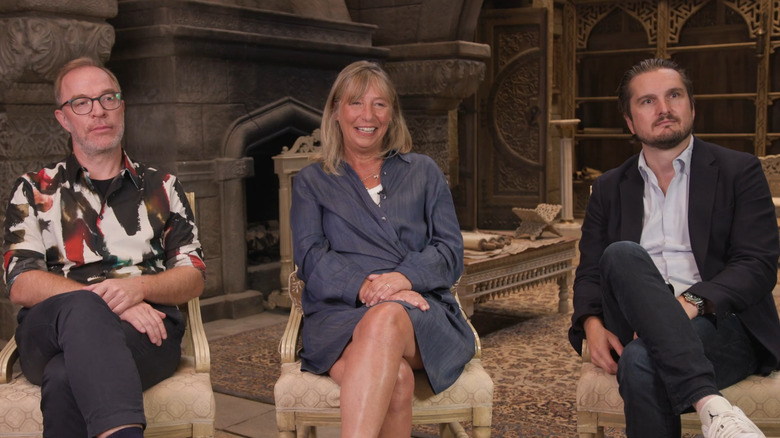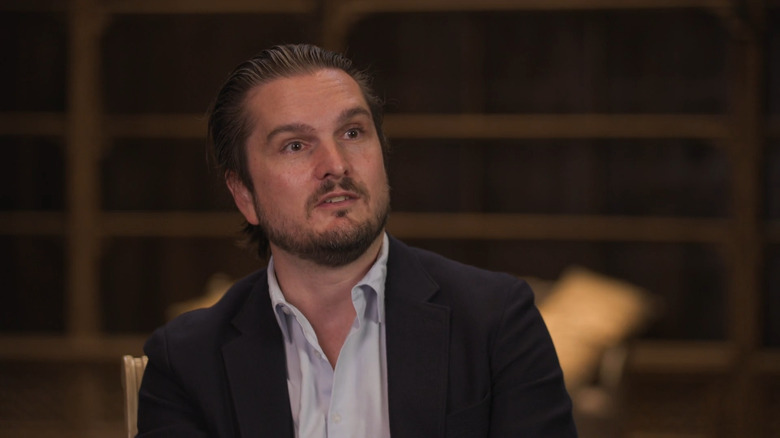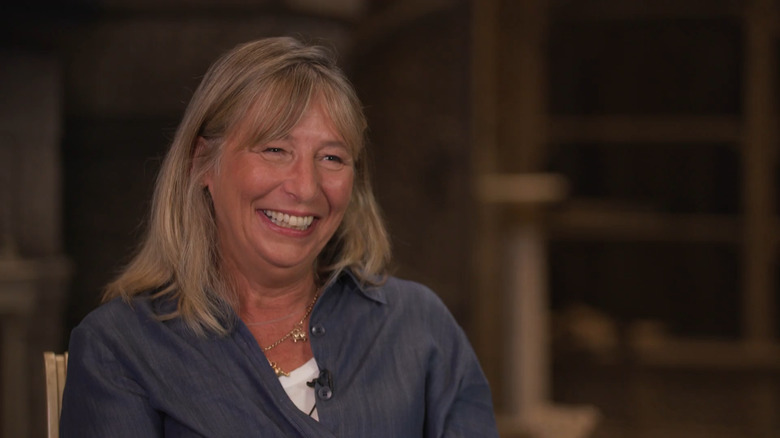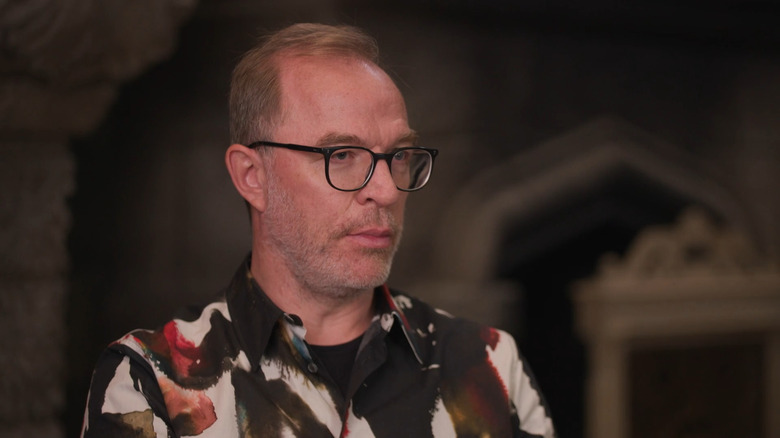Wheel Of Time S2 Producers Weber, Reibiger & Kehoe Created Their World With Over 300 Sets - Exclusive Interview
"The Wheel of Time" Season 2 is rolling out, and the massive adaptation of Robert Jordan's fantasy world is taking off fast. As the show grows, it is quickly becoming more complicated, interesting, and action-packed.
At the end of August, just before the new season dropped, Looper was invited to check out the production of the second season at Jordan Studios — a 350,000-square-foot reclaimed trucking facility in Prague that Amazon Studios has turned into a massive movie headquarters for its show. We were able to visit several sets, see stunt demonstrations, and ask questions — lots of questions.
At one point, we had the opportunity to catch up with not one, not two, but three of the masterminds behind the show. Executive producers Marigo Kehoe, Mike Weber, and Holger Reibiger sat down with us on set and answered some of our most burning questions regarding their show and the challenges and excitement that come with bringing such a gargantuan world to life.
The challenge of adapting a massive world to the streaming screen
What has been the most challenging part of adapting a world this big?
Mike Weber: The challenging thing for a big fantasy adaptation is having it stand out, not only in the context of adapting the source material but also having seen a lot of big fantasy adaptations subsequent to that. Having it feel fresh in the context of all of these shows that are out there — in addition to adapting the source material — is a challenge we're always aware of, because there's a lot of other great shows out there, but we want ours to be the best. We strive to have it stand out, not only from a great adaptation standpoint but also from the rest of the fantasy landscape out there.
Similar to that, David Goyer, who's the showrunner for "Foundation" on Apple TV+, recently mentioned in an interview the idea that getting a world like this — a story like this — set up and moving is very, very challenging. You don't want to lose your audience; you want to explain all the characters. In Season 2, there's a time jump, which can kill momentum. You've got to rebuild momentum. Going into Season 2, do we expect to see the speed of the show start to move forward?
Marigo Kehoe: I don't think we deliberately set a speed. The time jump is very easy to follow. We've seen Moiraine lose her power at the end of Season 1. We introduced a Seanchan at the end of Season 1, and you've seen the first episode now. You pick up with Moiraine, who's lost her power, and then you follow each of the characters on their individual journeys through to the end of the season.
It's got its own momentum. It does speed up. It is big. We've got a lot of action but a lot of source material, a lot of book stuff in there, which is great for the fans. As Mike said, we've changed a lot of stuff, but the speed and the journeys ... They're all doing their own things, so you jump and find them in different places, which gives its own momentum. And [it's] very character-driven, which is wonderful.
Source material, 14 books, and thousands of characters
Speaking of the source material, Season 1 pretty closely followed Book 1 as far as the story and where we got to. There are 14 books — I'm assuming not 14 seasons. How are you guys going to start to fit so much source material into this moving forward in Season 2 and beyond?
Holger Reibiger: That's more of a question to the writers and the showrunner, Rafe Judkins, but Season 2 is based on Book 2 and part of Book 3. If you think about how much source material it is to fit that into eight episodes, it's quite challenging. You try to pick the best moments and create as best as possible.
Kehoe: Rafe spoke to Brandon Sanderson about this. Book 2 and Book 3 have quite a similar arc ... so it was quite an easy fit to have the two joined to a degree.
With the character count, according to my research, there are over 2,700 named characters in the books — 148 points of view. Clearly, nobody wants to see that on the screen. That's a lot to track. What has it been like, reducing those into manageable plotlines that go through the story?
Weber: It's like Holger was saying: You pick your favorites, and you focus on them. That's what Rafe and the writers have done. You zero in on the most dramatic, the most emotional, the most action-oriented points of view, and you tell the story through their eyes, for the most part. That's easier for an audience to engage through.
Filming Season 2 in three different countries
You're clearly committed to a lot of practical effects and really cool sets. This is one of the biggest worlds in fantasy literature. How many sets did you build for Season 2, and how many more will you need to build to get through the show?
Reibiger: It's a difficult question to answer how many sets we build because each ... As our characters are on a journey, we establish a new world basically every episode. That means we have interior sets, exterior sets, bigger, smaller. Over the eight episodes, it's more than 250, 300 sets, and you're in one of the sets here.
Just for Season 2?
Reibiger: It's not just Season 2 — sometimes, we revamp.
Kehoe: We revamped a set.
Reibiger: We revamped from Season 1 to Season 2, or even between episodes — between Episodes 1 and 2 or 3 and 6 or something like that. That's a big challenge for us, to find locations and build sets. It's fantasy, so we want to create our own world. It's not that we can go on a location and shoot as it is. Normally, we even adapt location shooting. It's a lot to do.
How many countries have you filmed in at this point?
Reibiger: We filmed in three countries.
Kehoe: Three countries for Season 2.
Which three? Are you allowed to say, or is that ...?
Kehoe: We shot here and in Italy and Morocco, but three different places in Morocco. We moved. It's a big country.
Having now spent five years in this role, a long time, what is your favorite part of the Robert Jordan universe?
Weber: My favorite part of the Robert Jordan universe is the Ogier. I find them fascinating ... This original and engaging character that Jordan created is not like anything else that you've seen.
Kehoe: For me, probably the Forsaken, actually. Not because I like them, but they're extraordinary, complex characters, and you can see the human side as well as the bad. I love the way that [Jordan's] characters are balanced. [The Forsaken are] horrible people, but all of our actors enjoy playing the Forsaken because they have the two sides.
Reibiger: For me, what is interesting [is] the channeling. How we create the channeling, who can channel in different ways — it's always interesting, and we always try to improve it more. It's something very unique we haven't seen so much before.
The first three episodes of Season 2 of "The Wheel of Time" are available to stream on Prime Video. The remaining episodes will premiere on Fridays through October 6, 2023.
This interview has been edited for clarity.



